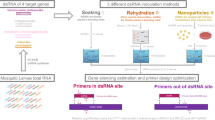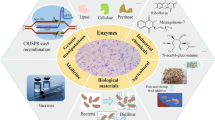Abstract
All major insecticidal genes of Bacillus thuringiensis var. israelensis (Bti) are controlled by the sporulation-specific sigma factor Sigma E (sigE), while sigE is negatively regulated by Sigma K (sigK). Therefore, knocking out sigK plays an important role in regulating the expression of insecticidal genes in Bti. A sigK deletion mutant of B. thuringiensis var. israelensis strain Bt-59, Bt59(ΔsigK), was constructed by homologous recombination and characterized. The sigK deletion resulted in no mature spores and delayed mother cell lysis from T25 to T60, while the genetically complemented strain, Bt59(HFsigK), had mother cell lysis at T25. Compared to Bt-59, sodium dodecyl sulfate polyacrylamide gel electrophoresis (SDS-PAGE) analysis indicated that the expression of Cry4Aa2/4Ba1 and Cyt1Aa1 proteins in Bt59(ΔsigK) increased approximately 1.67 and 1.21 times, respectively. However, there was no significant change in Cry11Aa1 protein expression between the two strains. Bioassay results showed that the sigK deletion mutation slightly reduced the insecticidal activity of Bt-59 against Culex pipiens pallens and did not obviously affect activity against Aedes albopictus.




Similar content being viewed by others
References
Ben-Dov E (2014) Bacillus thuringiensis subsp. israelensis and its dipteran-specific toxins. Toxins 6(4):1222–1243. https://doi.org/10.3390/toxins6041222
Prabakaran G, Hoti SL (2008) Application of different downstream processing methods and their comparison for the large-scale preparation of Bacillus thuringiensis var. israelensis after fermentation for mosquito control. Biologicals 36(6):412–415. https://doi.org/10.1016/j.biologicals.2008.06.001
Zhuang L, Zhou S, Wang Y, Chang M (2011) Mosquito biolarvicide production by sequential fermentation with dual strains of Bacillus thuringiensis subsp. israelensis and Bacillus sphaericus using sewage sludge. Bioresour Technol 102(2):1574–1580. https://doi.org/10.1016/j.biortech.2010.08.090
Pfannenstiel MA, Couche GA, Muthukumar G, Nickerson KW (1985) Stability of the larvicidal activity of Bacillus thuringiensis subsp. israelensis:aminoacid modification and denaturants. Appl Environ Microbiol 50(5):1196–1199. https://doi.org/10.1016/0141-4607(85)90029-0
Berry C, O'Neil S, Ben-Dov E et al (2002) Complete sequence and organization of pBtoxis, the toxin-coding plasmid of Bacillus thuringiensis subsp. israelensis. Appl Environ Microbiol 68(10):5082–5095. https://doi.org/10.1128/AEM.68.10.5082-5095.2002
Kang S, Odom OW, Malone CL, Thangamani S, Herrin DL (2018) Expression of a synthetic gene for the major cytotoxin (Cyt1Aa) of Bacillus thuringiensis subsp. israelensis in the chloroplast of wild-type Chlamydomonas. Biology 7(2):E29. https://doi.org/10.3390/biology7020029
Yoshisue H, Fukada T, Yoshida K, Sen K, Kurosawa S, Sakai H, Komano T (1993) Transcriptional regulation of Bacillus thuringiensis subsp. israelensis mosquito larvicidal crystal protein gene cryIVA. J Bacteriol 175(9):2750–2753. https://doi.org/10.1111/j.1574-6968.2009.01829.x
Yoshisue H, Nishimoto T, Sakai H, Komano T (1993) Identification of a promoter for the crystal protein-encoding gene cryIVB from Bacillus thuringiensis subsp. israelensis. Gene 137(2):247–251. https://doi.org/10.1016/0378-1119(93)90015-U
Yoshisue H, Sakai H, Sen K, Yamagiwa M, Komano T (1997) Identification of a second transcriptional start site for the insecticidal protein gene cryIVA of Bacillus thuringiensis subsp. israelensis. Gene 185(2):251–255. https://doi.org/10.1016/s0378-1119(96)00653-1
Dervyn E, Poncet S, Klier A, Rapoport G (1995) Transcriptional regulation of the cryIVD gene operon from Bacillus thuringiensis subsp. israelensis. J Bacteriol 177(9):2283–2291. https://doi.org/10.1128/jb.177.9.2283-2291.1995
Lereclus D, Agaisse H, Grandvalet C, Salamitou S, Gominet M (2000) Regulation of toxin and virulence gene transcription in Bacillus thuringiensis. Int J Med Microbiol 290(4–5):295–299. https://doi.org/10.1016/S1438-4221(00)80024-7
Lv J, Zhang X, Gao TT et al (2019) Effect of the spoIIID mutation on mother cell lysis in Bacillus thuringiensis. Appl Microbiol Biot 103(10):1–10. https://doi.org/10.1007/s00253-019-09722-1
Al-Hinai MA, Jones SW, Papoutsakis ET (2015) The Clostridium sporulation programs: diversity and preservation of endospore differentiation. Microbiol Mol Biol Rev 79(1):19–37. https://doi.org/10.1128/MMBR.00025-14
Piggot PJ, Hilbert DW (2004) Sporulation of Bacillus subtilis. Curr Opin Microbiol 7(6):579–586. https://doi.org/10.1016/j.mib.2004.10.001
Brehm SP, Staal SP, Hoch JA (1973) Phenotypes of pleiotropic-negative sporulation mutants of Bacillus subtilis. J Bacteriol 115:1063–1070. https://doi.org/10.1016/0006-2944(77)90037-0
Zheng L, Losick R (1990) Cascade regulation of spore coat gene expression in Bacillus subtilis. J Mol Biol 212:645. https://doi.org/10.1016/0022-2836(90)90227-d
Nugroho FA, Yamamoto H, Kobayashi Y, Sekiguchi J (1999) Characterization of a new Sigma-K-dependent peptidoglycan hydrolase gene that plays a role in Bacillus subtilis mother cell lysis. J Bacteriol 181:6230–6237. https://doi.org/10.1016/0022-2836(90)90227-d
Steil L, Serrano M, Henriques AO, Völker U (2005) Genome-wide analysis of temporally regulated and compartment-specific gene expression in sporulating cells of Bacillus subtilis. Microbiology 151:399. https://doi.org/10.1099/mic.0.27493-0
Sanchis V, Gohar M, Chaufaux J et al (1999) Development and field performance of a broad-spectrum nonviable asporogenic recombinant strain of Bacillus thuringiensis with greater potency and UV resistance. Appl Environ Microbiol 65(9):4032–4039. https://doi.org/10.1002/(SICI)1097-0290(19990905)64:5
Bravo A, Agaisse H, Salamitou S, Lereclus D (1996) Analysis of cryIAa expression in sigE and sigK mutants of Bacillus thuringiensis. Mol Gen Genet 250(6):734–741. https://doi.org/10.1007/BF02172985
Sambrook HC (1989) Molecular cloning: a laboratory manual. Cold Spring Harbor, New York
Lereclus D, Arantès O, Chaufaux J, Lecadet M (1989) Transformation and expression of a cloned δ-endotoxin gene in Bacillus thuringiensis. FEMS Microbiol Lett 60:211–217. https://doi.org/10.1111/j.1574-6968.1989.tb03448.x
Millet JH (1972) Experiments in molecular genetics. Cold Spring Harbor Press, New York
Crickmore N, Berry C, Panneerselvam S, Mishra R, Conno TR, Bonning BC (2020) A structure-based nomenclature for Bacillus thuringiensis and other bacteria-derived pesticidal proteins. J Invertebr Pathol. https://doi.org/10.1016/j.jip.2020.107438
Cutting S, Driks A, Schmidt R, Kunkel B, Losick R (1991) Forespore-specific transcription of a gene in the signal transduction pathway that governs Pro-sigma K processing in Bacillus subtilis. Genes Dev 5(3):456–466. https://doi.org/10.1101/gad.5.3.456
Kirk DG, Dahlsten E, Zhang Z, Korkeala H, Lindström M (2012) Involvement of Clostridium botulinum ATCC 3502 sigma factor K in early-stage sporulation. Appl Environ Microbiol 78(13):4590–4596. https://doi.org/10.1128/AEM.00304-12
Al-Hinai MA, Jones SW, Papoutsakis ET (2014) σK of Clostridium acetobutylicum is the first known sporulation-specific sigma factor with two developmentally separated roles, one early and one late in sporulation. J Bacteriol 196(2):287–299. https://doi.org/10.1128/JB.01103-13
Harry KH, Zhou R, Kroos L, Melville SB (2009) Sporulation and enterotoxin (CPE) synthesis are controlled by the sporulation-specific sigma factors SigE and SigK in Clostridium perfringens. J Bacteriol 191(8):2728–2742. https://doi.org/10.1128/JB.01839-08
Pereira FC, Saujet L, Tomé AR et al (2013) The spore differentiation pathway in the enteric pathogen Clostridium difficile. PLoS Genet 9(10):e1003782. https://doi.org/10.1371/journal.pgen.1003782
Fimlaid KA, Bond JP, Schutz KC et al (2013) Global analysis of the sporulation pathway of Clostridium difficile. PLoS Genet 9(8):e1003660. https://doi.org/10.1371/journal.pgen.1003660
Chen X, Gao T, Peng Q, Zhang J, Chai Y (2018) The novel cell wall hydrolase CwlC from Bacillus thuringiensis is essential for mother cell lysis. Appl Environ Microbiol 84(7):02640–02717. https://doi.org/10.1128/AEM.02640-17
Moar WJ, Trumble JT, Federici BA (1989) Comparative toxicity of spores and crystals from the NRD-12 and HD-1 strains of Bacillus thuringiensis suhsp. kurstaki to neonate beet armyworm (Lepidoptera: Noctuidae). J Econ Entomol 6:1593–1603. https://doi.org/10.1093/jee/82.6.1593
Johnson DE, McGaughey WH (1996) Contribution of Bacillus thuringiensis spores to toxicity of purified cry proteins towards Indianmeal moth larvae. Curr Microbiol 33(1):54–59. https://doi.org/10.1007/s002849900074
Zhang B, Struffi P, Kroos L (1999) σK Can negatively regulate sigE expression by two different mechanisms during sporulation of Bacillus subtilis. J Bacteriol 181(13):4081–4088
Fernandezluna MT, Lanzmendoza H, Gill SS, Bravo A, Soberon M, Mirandarios J (2010) An α-amylase is a novel receptor for Bacillus thuringiensis ssp. israelensis Cry4Ba and Cry11Aa toxins in the malaria vector mosquito Anopheles albimanus (Diptera:Culicidae). Environ Microbiol 12:746–757. https://doi.org/10.1111/j.1462-2920.2009.02117.x
Manasherob R, Bendov E, Xiaoqiang W, Boussiba S, Zaritsky A (2002) Protection from UV-B damage of mosquito larvicidal toxins from Bacillus thuringiensis subsp. israelensis expressed in Anabaena PCC 7120. Curr Microbiol 45:217–220. https://doi.org/10.1007/s00284-001-0106-5
Acknowledgements
We thank Dr. Didier Lereclus for his critical discussion and suggestions. We also thank Bin Xu, Fan Yang, Na Li, and Jilong Wen for participating in some of the work.
Funding
This work was supported by grants from the National Natural Science Foundation (31530095), the National Key Research and Development Program of China (2017YFD0200400), the Open-end fund of State Key Laboratory for Biology of Plant Diseases and Insect Pests (SKLOF201807), and Jiangsu Province Independent Innovation of Agricultural Science (Grant No. ZX(17)2002).
Author information
Authors and Affiliations
Corresponding authors
Ethics declarations
Conflict of interest
The authors declare that they have no conflicts of interest.
Ethical Approval
This article does not contain any studies with human participants or animals performed by any of the authors.
Additional information
Publisher's Note
Springer Nature remains neutral with regard to jurisdictional claims in published maps and institutional affiliations.
Rights and permissions
About this article
Cite this article
Xu, L., Han, G., Fan, X. et al. Characteristics of the sigK Deletion Mutant from Bacillus thuringiensis var. israelensis Strain Bt-59. Curr Microbiol 77, 3422–3429 (2020). https://doi.org/10.1007/s00284-020-02150-9
Received:
Accepted:
Published:
Issue Date:
DOI: https://doi.org/10.1007/s00284-020-02150-9




